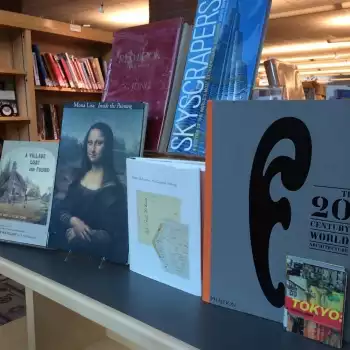
Perhaps the best part of browsing the shelves at the Princeton Public Library is stumbling across something truly unusual. It could be the content of the book or the form or both. I’ve been working here for quite awhile and below are some of my favorite finds. I encourage you to come in and check them out.
20th Century World Architecture
Phaidon Press put out this book and, weighing in at 18.5 pounds it may be the heaviest book in the library. In 832 pages it covers the finest built architecture from around the world completed between 1900 and 1999. The global scope of this wonderfully illustrated collection of over 750 key buildings juxtaposes architectural icons with regional masterpieces.Divided into six world regions and 29 sub-regions, over 80 countries are represented. Every building is located on maps that are defined by contemporary political geography with detailed information accompanying each project. If you don’t care to lug this massive tome home you can browse the beautiful buildings in our beautiful building.
Tokyo: a Certain Style
This tiny book published by Chronicle is almost the exact opposite of the book above in a couple of ways. One, obviously, is the size and weight of the book itself. The other is the narrow focus: this decor book shows how, for those living in one of the world’s most expensive and densely packed metropolises, closet-sized apartments stacked to the ceiling with gadgetry and CDs are the norm. Mind you, the apartments featured will never be in Architectural Digest. Instead we get an ultra-candid view on how urban Japanese manage to live in micro-sized spaces. This fascinating, voyeuristic look at modern life comes in an appropriately small format.
Emily Dickinson: The Gorgeous Nothings
This is the first full-color facismile of Dickinson’s manuscripts and presents this experimental work exactly as she wrote it. The 52 envelope writings offer a glimpse into the process of one of the most important poets. This is for fans of Emily, poetry, and the writing process.
Mona Lisa: Inside the Painting
Leonardo’s Mona Lisa is so well known that we think we have heard everything about it. This book is a report from the front of painting conservation science. Advances in radiography, optical scanning, infrared reflectography and a number of other new techniques have revealed a wealth of new information about the panel on which the Mona Lisa was painted, the underdrawing and underpainting of the image, the paint surface and the materials that went into each. This is a step-by-step analysis of how the painting was made, seen through the most exacting scientific eye. It offers new insight not only into the mind of Leonardo, but into the world of Renaissance painting as well. It’s a fascinating read to anyone seriously interested in the technique of painting.
A Village Lost and Found
Based on 30 years of research, Brian May’s painstaking excavation of stereo photographs from the dawn of photography transports readers to an Oxfordshire village of the 1850s. May, best known as the guitarist for Queen, included is a reproduction of T. R. Williams’ 1856 series of stereo photographs “Scenes In Our Village.” This unique book comes with it’s own stereoscopic viewer so the reader can see the pictures as they were meant to be seen. The book is also something of a detective story, as the village itself was only identified in 2003 as Hinton Waldrist in Oxfordshire, and the authors’ research constantly reveals further clues about the society of those distant times.
The Red Book (Liber Novus)
Another truly massive tome, this has been called he most influential unpublished work in the history of psychology. When Carl Jung embarked on an extended self-exploration he called his “confrontation with the unconscious,” the heart of it was The Red Book, a large, illuminated volume he created between 1914 and 1930. Here he developed his principle theories — of the archetypes, the collective unconscious, and the process of individuation — that transformed psychotherapy from a practice concerned with treatment of the sick into a means for higher development of the personality. While Jung considered The Red Book to be his most important work, only a handful of people had ever seen it. This volume is a complete facsimile and English translation. It is an astonishing example of calligraphy and art on a par with the illuminated manuscripts of William Blake.
Skyscrapers: A History of the World’s Most Extraordinary Buildings
At a stunning 18 inches tall and celebrating all of today’s most significant superstructures, this revised edition of Judith Dupre’s book features full-color photographs, and profiles of over 70 building around the world.
The next time you are in the library take some time to browse and see if you can add any unique and incredible books to this list.
